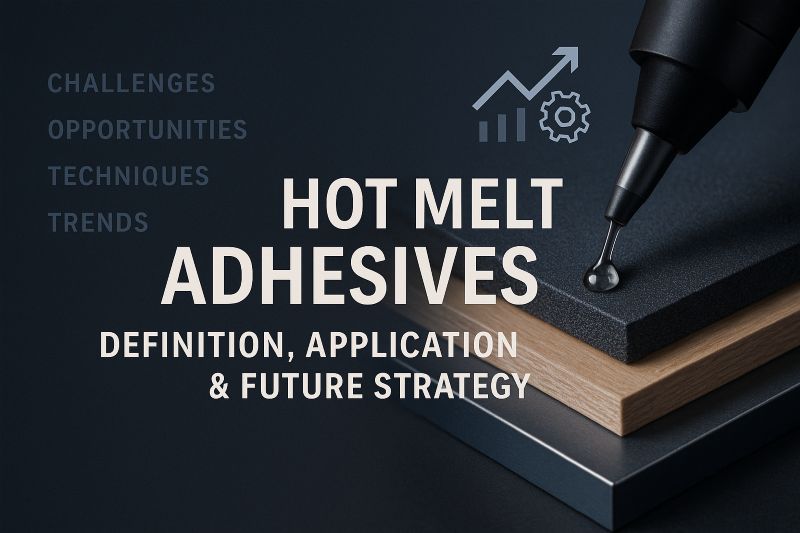
Definition of Hot Melt Adhesives
Types of Hot Melt Adhesives
Importance in Modern Industries
Application Methods and Techniques
Latest Trends in Applications
Future Strategies for Development
Challenges and Opportunities
Frequently Asked Questions (FAQ)
Hot melt adhesives are thermoplastic materials that are solid at room temperature but become flowable when heated, allowing for quick and durable bonding. Upon cooling, they return to a solid state, forming strong seals without the need for water or solvent evaporation. These adhesives play a vital role in high-speed, automated industries including packaging, automotive components, consumer electronics, and textile bonding. Advanced formulas have been developed for faster setting, cleaner application, and lower emissions, making them key to improving both operational efficiency and environmental performance.
Hot melt adhesives are available in several formulations, each tailored for specific industrial needs:
EVA-based (Ethylene Vinyl Acetate): Common in packaging for its balance of flexibility and affordability.
Polyolefin-based: Valued for chemical resistance and moisture stability, suitable for automotive and construction.
Polyurethane-based (PUR): Offers high bond strength and is often used in textile and electronics assembly.
Polyamide-based: Known for fast curing, high thermal resistance, and excellent adhesion in demanding environments.
Modern manufacturing demands materials that can perform under automated, high-volume conditions. New-generation polyamide formulations are optimized for clarity, low odor, and energy-efficient bonding.
Hot melt adhesives support industries where speed, clean processing, and sustainability are critical. Their fast-setting nature enables rapid assembly lines without secondary curing processes. Key application areas include:
Packaging: Clean sealing and tamper resistance
Electronics: Internal component bonding with thermal protection
Automotive: Interior trim and headlamp sealing
Appliances & Furniture: Structural bonding and decorative lamination
These adhesives also contribute to waste reduction, energy savings, and simplified logistics by eliminating drying or ventilation steps.
Application methods vary depending on substrate type, adhesive formulation, and production goals:
Slot Die Coating: Ideal for precision in electronics and battery assembly
Spray Systems: Suitable for high-speed or irregular surface bonding
Roll Coating: Used for wide or continuous surfaces in furniture or paper lamination
Nozzle Dispensing: Flexible and accurate, ideal for automated robotic systems
Modern hot melt adhesives are formulated to offer excellent flow control, thermal stability, and minimal char formation, ensuring consistent performance across different machinery and processes.
Recent trends reflect the industry's focus on sustainability, automation, and enhanced material compatibility:
Low-Emission Formulations: Designed to reduce VOCs and support workplace safety
Automation-Friendly Grades: Developed for high-speed lines with minimal downtime
Bio-Based and Recyclable Variants: Supporting circular economy practices
Smart Adhesives: Responsive to temperature or pressure, enabling real-time performance adaptation
As regulatory and consumer pressure for sustainable production increases, hot melt adhesives are evolving to align with broader ESG (Environmental, Social, and Governance) goals.
Future development of hot melt adhesives centers around:
Eco-Friendly Innovation: Using renewable raw materials and reducing energy consumption
Integration with Smart Systems: Adhesives compatible with Industry 4.0-enabled machines
Advanced Dispensing Technologies: Ensuring micro-precision with reduced material waste
Customizable Formulations: Tailored for substrate compatibility, reworkability, and low-temperature operations
The industry is shifting toward adhesives that can adapt to changing environmental policies, reduce carbon footprints, and improve line efficiency.
Balancing green certifications with high-performance bonding
Adapting to rapid changes in production technologies
Managing temperature sensitivity and storage stability
Expansion in biodegradable packaging materials
Adoption in lightweight electric vehicle assembly
Integration with automated, sensor-controlled systems
High-performance hot melt adhesives are increasingly seen as strategic assets in improving both product and process sustainability.
What are hot melt adhesives?
They are thermoplastic bonding agents that are heated for application and solidify upon cooling, forming durable seals.
What types of hot melt adhesives are available?
Common types include EVA, polyolefin, polyurethane, and polyamide—each suited for different manufacturing needs.
Why are they important in modern industries?
They enable fast, clean, and reliable bonding, making them essential for automated manufacturing, packaging, electronics, and more.
What are typical application methods?
Slot die coating, spray systems, roll coating, and robotic nozzles are widely used, depending on the process requirements.
What trends are shaping the future of hot melt adhesives?
Trends include low-emission formulations, automation compatibility, and development of bio-based materials.
What future innovations are expected?
Eco-friendly chemistry, smarter dispensing systems, and customized formulations for recyclable materials are driving innovation.
What challenges does the industry face?
Balancing performance with environmental compliance and adapting to new machinery and production speeds are key hurdles.
How do hot melt adhesives support sustainability?
Modern formulations reduce waste, operate at lower temperatures, and are compatible with recyclable and compostable substrates.